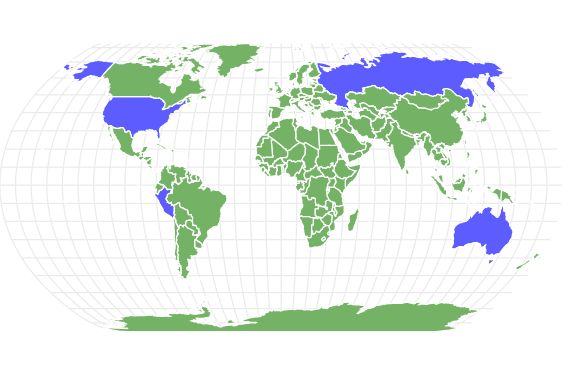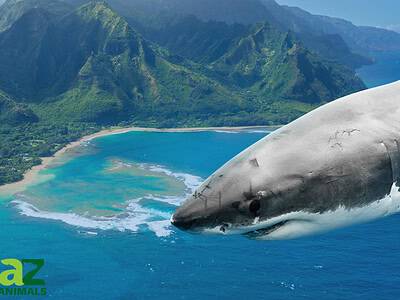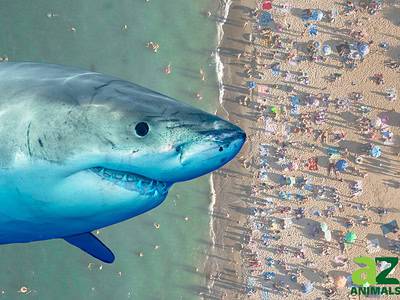Yellow-Bellied Sea Snake
Hydrophis platurus
Sea snakes spend approximately 90% of their lives under water.
Advertisement
Yellow-Bellied Sea Snake Scientific Classification
- Kingdom
- Animalia
- Phylum
- Chordata
- Class
- Reptilia
- Order
- Squamata
- Family
- Elapidae
- Genus
- Hydrophis
- Scientific Name
- Hydrophis platurus
Read our Complete Guide to Classification of Animals.
Yellow-Bellied Sea Snake Conservation Status
Yellow-Bellied Sea Snake Facts
- Prey
- Fish, including mullets, jacks, anchovies, and damselfish
- Fun Fact
- Sea snakes spend approximately 90% of their lives under water.
- Biggest Threat
- Water pollution
- Most Distinctive Feature
- Bright yellow belly
- Distinctive Feature
- Paddle-shaped tail
Yellow-Bellied Sea Snake Physical Characteristics
- Skin Type
- Scales
- Lifespan
- 2-7 years
- Length
- 3-4 ft
- Venomous
- Yes
- Aggression
- High
View all of the Yellow-Bellied Sea Snake images!
The yellow-bellied sea snake has the largest habitat range of any snake species in the world.
The yellow-bellied sea snake belongs to a unique genus that inhabits marine environments. It stays in the water during its entire life and cannot even properly move or stay upright on land. The species has many unique adaptations to help it survive life at sea: the nostrils are positioned high on the snout to breathe at the surface and the tapered belly provides stability in the water like the keel of a boat. This article will cover even more interesting facts about its habitat, diet, and hunting strategy.
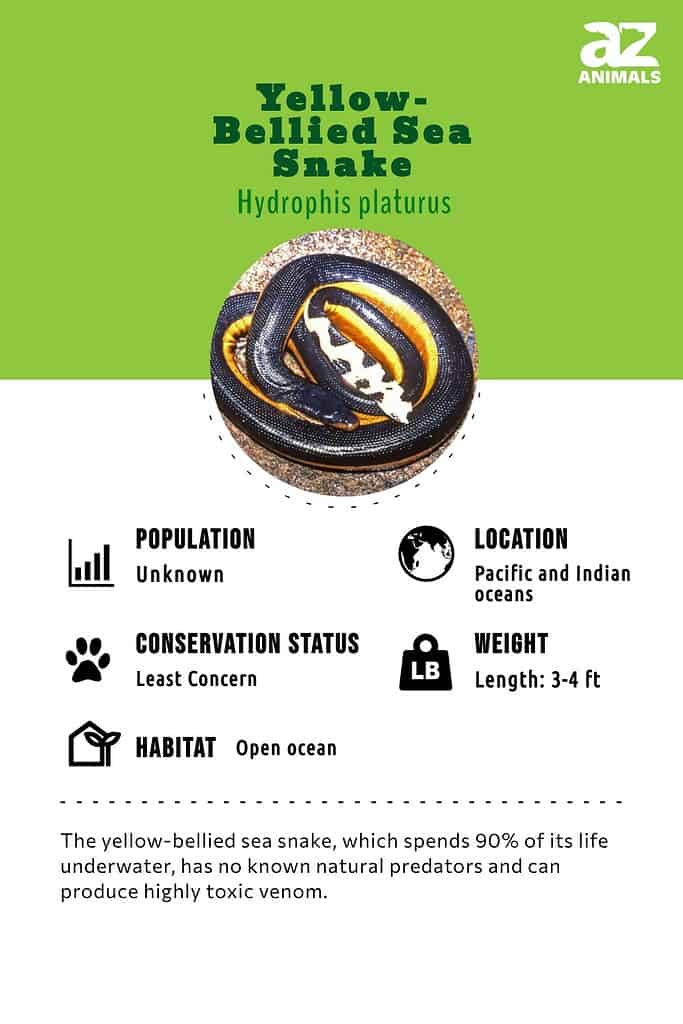
4 Amazing Yellow-Bellied Sea Snake Facts!
- The yellow-bellied sea snake moves through the water both forward and backward by waving its entire body back and forth with its paddle-shaped tail. It can achieve short bursts of speed at about 3 feet per second.
- In order to shed its loose skin and remove any algae or barnacles, the yellow-bellied sea snake will twist its entire body up into a kind of pretzel and create friction by rubbing its body parts against each other. The snake sheds its skin about once every two or three weeks in captivity.
- The yellow-bellied sea snake has few known predators in the wild. The bright yellow coloration is a warning of its poisonous nature. In tests, some animals have refused to even eat its flesh.
- This snake spends about 90 percent of its life underwater and can stay submerged for about 90 minutes at a time, sometimes even longer, before returning to the surface.
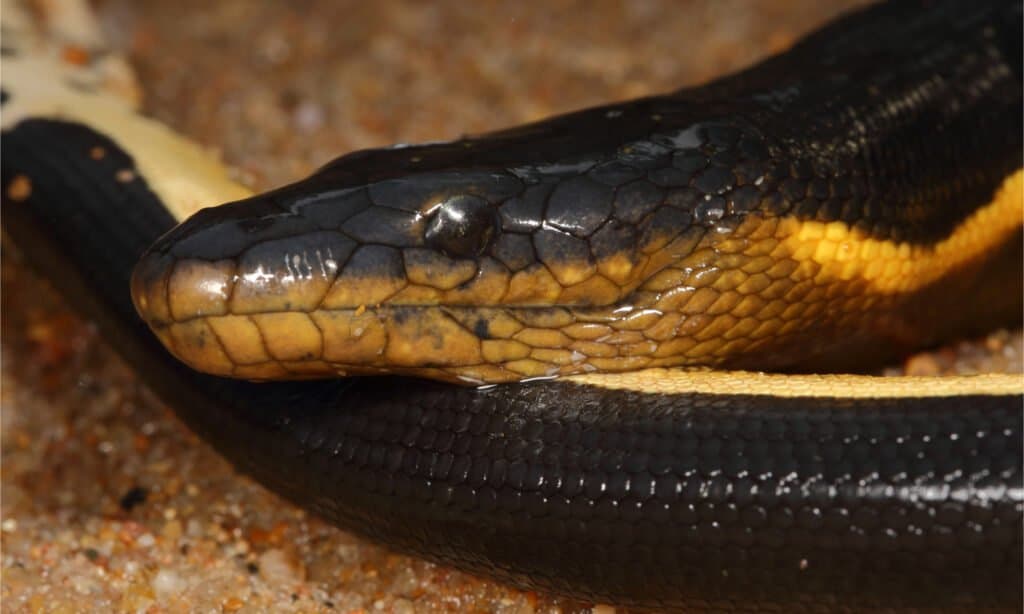
The yellow-bellied sea snake sheds its skin regularly.
©NickEvansKZN/Shutterstock.com
Scientific Name
The scientific name of the yellow-bellied sea snake is Hydrophis platurus. Hydrophis literally means water serpent in ancient Greek. Platurus likewise means flattened tail.
It is closely related to other types of sea snakes in the same genus such as the slender-necked sea snake, olive-headed sea snake, and Peters’ sea snake.
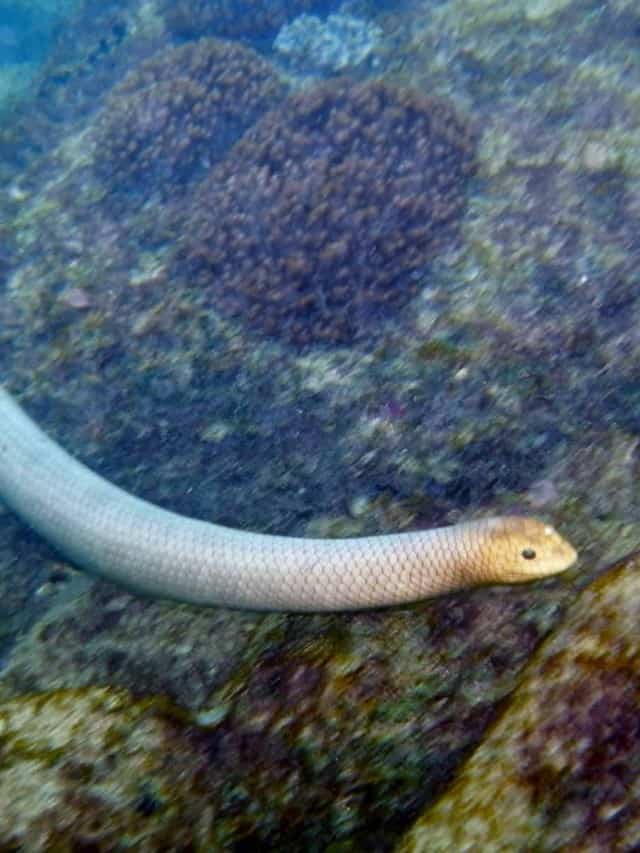
The yellow-bellied sea snake belongs to the same genus as the olive-headed sea snake.
©Sahara Frost/Shutterstock.com
Evolution and Origins
Sea snakes belong to the Hydrophis genus in the subfamily Hydrophiinae, which split from Australasian venomous snakes of the family Elapidae around 10 million years ago.
Members of Hydrophiinae include most sea snakes and many types of venomous snakes present in Australasia, such as taipans, tiger snakes, brown snakes, and death adders.
Appearance
The yellow-bellied sea snake is easily identified by its bright yellow-colored body. This is accompanied by a long black or dark brown stripe along the back that becomes spotted near the paddle-shaped tail. The head is long and blunt. The large eyes have a dark blue iris. The scales are small, smooth, and hexagonal in shape. The entire body can reach up to 4 feet long, and females are several inches longer than males on average.
Here is how to identify the yellow-bellied sea snake:
- Bright yellow-colored body
- Dark stripe on the back that turns into spots
- Paddle-shaped tail
- Long head and blunt snout
- Small hexagonal-shaped scales.
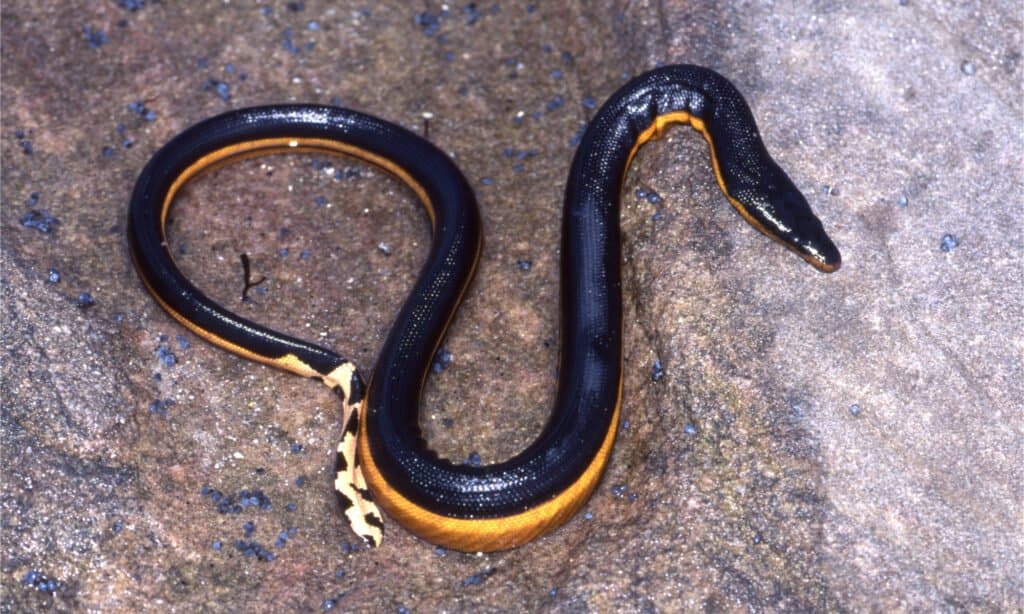
The yellow-bellied sea snake has small hexagonal-shaped scales and a paddle-shaped tail.
©Ken Griffiths/Shutterstock.com
Behavior
One of the most interesting facts is that the yellow-bellied sea snake spends about 90 percent of its life underwater. They can stay submerged for about 90 minutes at a time and sometimes even longer before returning to the surface. The rich supply of blood vessels in the skin acts kind of like gills in the water to help it breathe. These blood vessels also have the ability to release a lot of nitrogen quickly, perhaps reducing the chances of suffering from the bends (decompression sickness, when gas bubbles form inside of body tissue) as it surfaces rapidly.
Because they tend to live out in the open ocean, the yellow-bellied sea snake is rarely encountered by people unless it happens to wash up somewhere close to the shore. They do have the tendency to bite if mishandled or threatened in some way. If you ever see one washed up on the beach, even if it’s sluggish and slow-moving, you should never try to handle one yourself. You should instead call a local wildlife control agency to take care of it.
Fishers from Southeast Asia are most likely to accidentally encounter one and suffer from a bite, but there have been no reported attacks in Hawaii or the rest of the United States.
How Dangerous Are Yellow-Bellied Sea Snakes?
The yellow-bellied sea snake has the ability to produce highly toxic venom that causes muscle pain, stiffness, drowsiness, vomiting, and even paralysis. Deaths can even occur in a small number of serious untreated cases. A highly effective antidote that neutralizes the venom is available, but medical treatment must be sought as soon as possible to minimize any long-term effects and permanent damage to the body. Fortunately, the small fangs mean that only a small amount of toxin can be injected at a time. They also have the ability to control the amount of venom they inject, saving most of it for when they’re hunting prey. Defensive bites may not deliver any venom at all.

Habitat
The yellow-bellied sea snake is found all throughout the Indian and Pacific Oceans. Its natural habitat range traces a long line from the coast of Southern and Eastern Africa, to the entire coast of Asia up to the border of Russia, and most of the major Pacific Islands, including Hawaii and Australia. It is also found along the coast of the Americas, from southern California to Peru.
Unlike many other types of sea snakes, this species is most likely to be found in open oceans, a short distance from any land. Their favorite location for hunting and breeding is the sea kelp mats found in the ocean. They ride the ocean currents to travel between locations.

Yellow-bellied sea snakes can be found in the Pacific and Indian oceans.
©John Fader/Shutterstock.com
Diet
The yellow-bellied sea snake is carnivorous and feeds almost exclusively on fish. Some of their favorites include mullets, jacks, anchovies, damselfish, and eels.
In captivity, sea snakes are typically fed fish (dead or alive), whole or in pieces, as well as frogs.
It’s believed that sea snakes receive the water they need by using their salt glands to filter seawater, and they can drink fresh water from creeks or springs or rainwater on the surface of oceans.
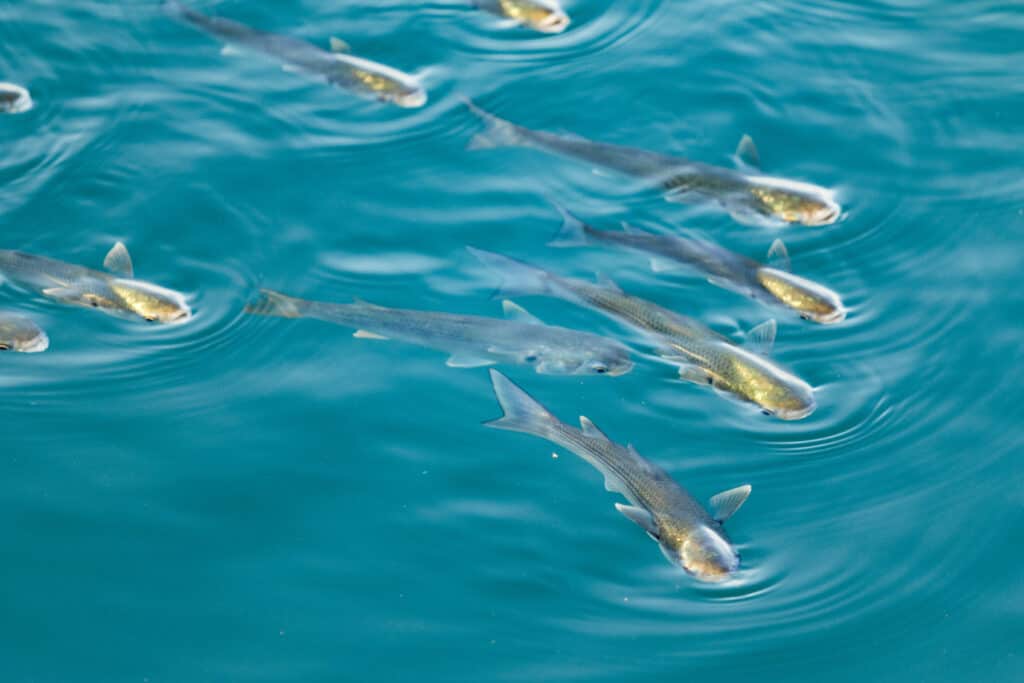
Mullets, which travel in schools, are part of the yellow-bellied sea snake’s diet.
©KZWW/Shutterstock.com
Predators and Threats
While other sea snake species are preyed upon in their habitats, the yellow-bellied sea snake is unusual in that it does not appear to have natural predators. Possible predators such as larger fish, sea birds, and aquatic mammals have not been observed attacking this sea snake, likely due to its potent venom and bright coloring acting as a warning to other animals. In studies where fish were given the sea snake to eat, they rejected it and if they did consume it, vomited it up after. Two instances of recorded natural predation, when a pufferfish and a leopard seal killed and ate a yellow-bellied sea snake, also resulted in the predators regurgitating their meal.
Some marine invertebrates, such as a species of barnacle that is found only on sea snakes, do not harm these snakes but can slow them down so the reptile regularly sheds its skin to remove the organisms.
Humans are probably the biggest threat to the yellow-bellied sea snake due to destroying their habitats through water pollution.
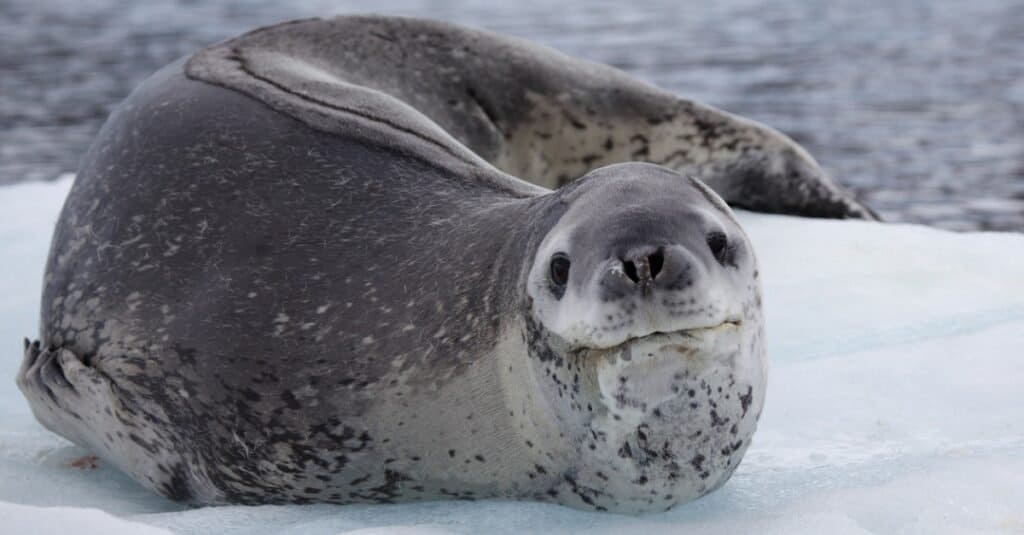
In one instance of a
leopard
seal eating a yellow-bellied sea snake, the seal threw up its meal after.
©Mogens Trolle/Shutterstock.com
Reproduction, Babies, and Lifespan
The breeding season of the yellow-bellied sea snake may occur all year round or just during the summer. The female gives birth to about two to six live young after a gestation period lasting five or six months. The juveniles have the ability to start hunting for food almost immediately from birth.
It’s not known exactly how long yellow-bellied sea snakes typically live in the wild, but estimates range from 2-4 years to 5-10 years. In captivity, these snakes can live for around 2-3 years on average.
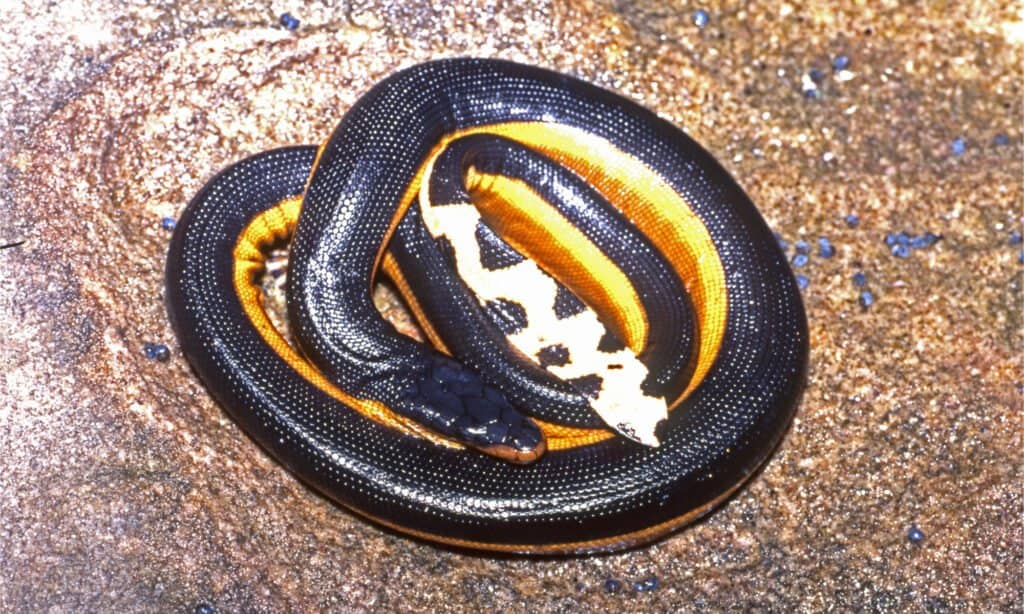
The breeding season of the yellow-bellied sea snakes can be all year round.
©Ken Griffiths/Shutterstock.com
Population and Conservation
According to the IUCN Red List, the yellow-bellied sea snake is a species of Least Concern.
Population numbers have not been properly estimated, but they appear to be stable and among the most widely distributed snakes in the world. It has few threats in the wild except perhaps for water pollution.

The IUCN’s Red List categorizes the yellow-bellied sea snake as of Least Concern.
©Tobias Arhelger/Shutterstock.com
Yellow-Bellied Sea Snake FAQs (Frequently Asked Questions)
Are yellow-bellied sea snakes venomous?
Are yellow-bellied sea snakes venomous?
How do yellow-bellied sea snakes hunt?
The yellow-bellied sea snake waits motionless near the surface for prey to swim beneath it. The snake will then strike at the prey with its surprising speed, using the venom to subdue it. This species is likely to target entire schools of fish rather than individuals. This ensures it is maximizing the efficiency of its hunt.
Are yellow-bellied sea snakes aggressive?
The yellow-bellied sea snake is considered to be aggressive and should be avoided at all costs.
Where do yellow-bellied sea snakes live?
The yellow-bellied sea snake lives in many different locations throughout the Indian and Pacific Oceans. It is most commonly found in the open oceans a short distance from the shore. This species is also the only sea snake to have reached Hawaii and one of two in New Zealand.
What do yellow-bellied sea snakes eat?
The yellow-bellied sea snake feeds almost exclusively on fish. Some of their favorite meals include mullets, jacks, anchovies, and damselfish.
How poisonous is the yellow-bellied sea snake?
The yellow-bellied snake has enough venom to kill a person in a single bite.
What happens if a yellow-bellied sea snake bites you?
The venom is made from a combination of various neurotoxins which, as the name implies, directly attack the nervous system of its victim by blocking the transmission of messages from the nerves to the muscles. In severe cases, partial or complete paralysis, cardiac arrest, or renal failure may result.
Can you touch a yellow-bellied sea snake?
It is not a good idea to handle this species, because if you make physical contact, it does have the tendency to bite.
Thank you for reading! Have some feedback for us? Contact the AZ Animals editorial team.
Sources
- Australian Museum / Accessed May 6, 2022
- Waikiki Aquarium / Accessed May 6, 2022
- Australian Geographic / Accessed May 6, 2022

